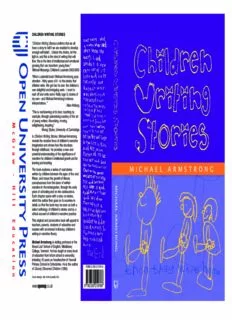
Children Writing Stories PDF
Preview Children Writing Stories
Children writing...pb 6/1/06 10:10 am Page 1 CHILDREN WRITING STORIES “Children Writing Storiesconfirms that we all have a story to tell if we are enabled to develop enough self-belief... Unlock the chains, let the light in, and this is the kind of writing that will flow, this is the kind of intellectual and emotional growing that can transform young lives.” Michael Morpurgo, Children’s Laureate 2003-2005 “What a splendid book! Michael Armstrong pays attention - thirty years of it - to the stories that children write. We get two for one: the children’s own delightful and intriguing work - I want to rush off and write some Wally (age 5) stories of my own - and Michael Armstrong’s intense interpretations. ” Allan Ahlberg “This is real learning at its best, teaching by example, through painstaking scrutiny of the art of young writers. Absorbing, moving, enlightening, inspiring.” Morag Styles, University of Cambridge In Children Writing Stories, Michael Armstrong reveals the creative force of children's narrative imagination and shows how this develops through childhood. He provides a new and powerful understanding of the significance of narrative for children’s intellectual growth and for learning and teaching. M I C H A E L A R M S T R O N G The book explores a series of real stories written by children between the ages of five and fifteen, and traces the growth of literary consciousness from the dawn of written narrative in the kindergarten, through the early M years of schooling and on into adolescence. I C Each chapter opens with a story or stories, H which the author then goes on to examine in A detail, so that the book may be seen as both a E select anthology of children’s stories and as a L critical account of children’s narrative practice. A This original and provocative book will appeal to R teachers, parents, students of education and M readers with an interest in literacy, children's S writing or narrative theory. T R O Michael Armstrongis visiting professor at the N Bread Loaf School of English, Middlebury G College, Vermont. He has taught at every level of education from infant school to university, including 18 years as headteacher of Harwell Primary School in Oxfordshire. He is the author (cid:10)(cid:11)(cid:12)(cid:13)(cid:14)(cid:4)(cid:15)(cid:5)(cid:5)(cid:6)(cid:15)(cid:7)(cid:8)(cid:1)(cid:2)(cid:9)(cid:15)(cid:16) of Closely Observed Children(1980). Cover design: del norte (Leeds) Ltd www.openup.co.uk (cid:1) (cid:2)(cid:3)(cid:4)(cid:5)(cid:5)(cid:6) (cid:7)(cid:8)(cid:1)(cid:2)(cid:9)(cid:9) CHILDREN WRITING STORIES ‘‘Here’sabook,awonderfulbookthatenablestheenablertoenable.ThefirstbookIever compiled35yearsagowasacollectionofchildren’swriting.Iwasateacheratthetime,andI wasfiredbythefreshness,theeagerness,thehonestyofthewritingmystudentswerepro- ducing.HereisaworthysuccessortoTedHughes’PoetryintheMaking,thebookthatenabled metogaintheconfidencetobegintofindmyownvoiceasastoryteller. ChildrenWritingStoriesconfirmsthatweallhaveastorytotellifweareenabledtodevelop enoughself-belief.Somuchofournaturalcreativityissmotheredduringourschoolyears. Teachersandchildrenfeelhemmedinbythestricturesofacurriculumwhichsimplydoes notallowroomforcreativitytobreathe.Unlockthechains,letthelightin,andthisisthe kindofwritingthatwillflow,thisisthekindofintellectualandemotionalgrowingthatcan transformyounglives.’’ MichaelMorpurgo,Children’sLaureate2003–2005 PayAttention! ‘‘Whatasplendidbook!MichaelArmstrongpaysattention–thirtyyearsofit–tothestories thatchildrenwrite.Wegettwoforone:thechildren’sowndelightfulandintriguingwork–I wanttorushoffandwritesomeWally(age5)storiesofmyown–andMichaelArmstrong’s intenseinterpretations.There’saddeddepthheretoo;hewastheirteacher.Hisknowledgeof thechildbehindthestoryenricheshiscloseobservations,roundsthemout.Myfavouritetale is,probably,‘GirlToday,HareTomorrow’byRebecca(age11).You’llassuredlyfindyours. Readon!’’ AllanAhlberg ‘‘Ageniusobserverofyoungchildren,MichaelArmstronginspiresallteacherstolook,listen, andenterintoconversationswithchildren,theirart,andtheirwritings.Hispatience,unique insights,andclosereadingsofchildren’sstoriesbearwitnesstothepowerofteacherintuition opentothewisdomthatcomesfromyearsoflearningwithandfromchildren.’’ ShirleyBriceHeath ‘‘Thebookisbothtimelyandtimeless,toweringabovethebanalityofofficialendorsements of children’s creativity and the current structures of classroom literacy. Armstrong most beautifullydemonstrates,onceandforall,thatchildrenarenotthelittleghostsofadults,but powerfulthinkers,dreamers,socialcritics,satiristsandvisionariesintheirownright,andin waysoftheirowninvention.Thisisnotatextbook,butoneofthoserarebooksthatwill exciteandinspire;itwillbereadforpersonalaswellasprofessionalbenefit,notinorderto passexams,ormeetstandardsofcompetence.’’ MaryJaneDrummond ‘‘Michael Armstrong’s brilliant interpretations of narratives by children teaches us that children’sstoriescanbeanalysedwiththesamerigorasthosewrittenbyadults.Alongthe way,healsomakesanimportant,evenradical,point:Youngchildrenthinklikeartists,and thebestteacherstakeadvantageofthisnaturalpassionbyputtingcreativityatthecenter, ratherthantheperiphery,ofeducation.’’ SamSwope ‘‘OneofMichaelArmstrong’sstrongthemes–‘teachingasinterpretation’–mayseematfirst asurprisingidea.IknowfrompersonalexperiencehowMichael’sintenserespectforeach individualstory-makerhasprofoundlyinfluenced20summersofteachersinhisclassesatthe BreadLoaf SchoolofEnglish.Now, withthisbook,manymorecanlearnfrom thisgifted teacher.’’ CourtneyCazden,HarvardGraduateSchoolofEducation ‘‘What a joy! Homage to Tolstoy apart, a whole book dedicated to insightful analysis of children’swrittenstoriesbyagiftedteacher.ArmstrongtaughtusinCloselyObservedChildren howtolookandlistentochildrenandtaketheirartisticendeavoursseriously.Thisbooklives up to its excellent predecessor. Forget the tangled webs of the National Literacy Strategy wastingmillionsoftreesandpoundswithitsprescriptive,mechanisticmessage.Thisisreal learningatitsbest,teachingbyexample,throughpainstakingscrutinyoftheartofyoung writers.Absorbing,moving,enlightening,inspiring.’’ MoragStyles CHILDREN WRITING STORIES MICHAEL ARMSTRONG Open University Press OpenUniversityPress McGraw-HillEducation McGraw-HillHouse ShoppenhangersRoad Maidenhead Berkshire England SL62QL email:[email protected] worldwideweb:www.openup.co.uk andTwoPennPlaza,NewYork,NY10121-2289,USA Firstpublished2006 Copyright#MichaelArmstrong2006. Allrightsreserved.Exceptforthequotationofshortpassagesforthepurposesof criticismandreview,nopartofthispublicationmaybereproduced,storedina retrievalsystem,ortransmitted,inanyform,orbyanymeans,electronic, mechanical,photocopying,recordingorotherwise,withoutthepriorpermission ofthepublisheroralicencefromtheCopyrightLicensingAgencyLimited.Details ofsuchlicences(forreprographicreproduction)maybeobtainedfromthe CopyrightLicensingAgencyLtdof90TottenhamCourtRoad,LondonW1T4LP. AcataloguerecordofthisbookisavailablefromtheBritishLibrary ISBN-10:03350219764(pb)0335219772(hb) ISBN-13:9780335219766(pb)9780336219773(hb) LibraryofCongressCataloguing-in-PublicationData CIPdataappliedfor TypesetbyYHTLtd PrintedinPolandbyOZGrafS.A.www.polskabook.pl CONTENTS Preface: Thinking aboutchildren’s stories ix 1 Conscious creativity: Reflectionsonanessay byLeoTolstoy 1 The Life ofaSoldier’s Wife, byFyedka,age11 1 2 Origins of apractice: Afiveyear old’smythology 27 NineStories,by Wally,age 5 27 3 Image and text:Enteringaliterary world 43 The PoorlyMouse, byJessica, age 6 45 The LittleGirl WhoGot Lost, byMelissa, age6 57 4 Encoding themarvellous:Narrative thoughtat nine yearsold 85 Six Tales,by Lydia,age8–9 85 5 Appropriating Trickster: Thestory of Laura andtheworkshop 121 UpsetterFinds the FourLeaf CloverCircuit, byLaura, age9 121 6 Into thebeyond: Imagination and reality 137 Threetales of theimagination,by Rebecca,ages11 and 16 137 7 The pedagogy of theimagination 166 WalkingThrough the Wood, byLeoTolstoy 182 References 187 for JennyGiles and inmemoryof Brian Simon PREFACE: THINKING ABOUT CHILDREN’S STORIES Thisisabookaboutthestoriesthatchildrenwrite:abouttheirliteraryform, about their aesthetic and ethical content, about their significance for an understanding of intellectual growth, learning and teaching, education as a culturalenterprise.Thebookisthesequeltoanearlierwork,CloselyObserved Children, first published in 1980. In Closely Observed Children, I set out to describetheintellectuallifeofaclassofeight-tonine-year-oldchildrenina primaryschoolinruralLeicestershire.InparticularIwantedtodocumentthe seriousness of purpose which I witnessed in children’s thought and action, their ‘high intent’, as I called it (Armstrong 1980: 206). That seriousness, at onceearnestandplayful,wasevidentineveryaspectofthesechildren’swork: intheir writing, theirart, theirmathematics, their model making, theirnat- ure study.I was led toconclude that from their earliest acquaintance with the various traditions of human thought, with literature, art, mathematics, science, and the like, [chil- dren]struggletomakeuseoftheseseveraltraditions,of theconstraints which they impose as well as the opportunities which they present, to examine,extendandexpressinafittingformtheirownexperienceand understanding. (1980: 129) Thelifeofreason,Iargued,wascoterminouswiththebeginningsoflearning. Thepresentbooktakeschildren’shighintentforgranted.Mypurposeisto explorethewaysinwhichthatintentismanifestedinoneparticulardomain, that of written narrative. What follows is a sequence of studies in literary imagination,aninvestigationintothenaturalhistoryofnarrativeduringthe yearsofchildhood.Intheprefacetohisthree-volumemasterpiece,Timeand Narrative(1984),PaulRicoeurdefinesnarrative,or,morepreciselytheplot,as ‘the privileged means by which we reconfigure our confused, unformed and atthelimitmutetemporalexperience’(1984:xi).Ricoeurdrawshisexamples
Description: